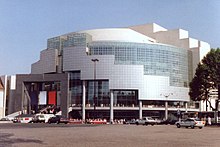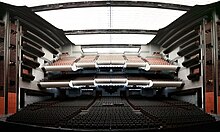Opera Bastille
The Opéra Bastille (Bastille Opera House) is one of the two Parisian opera houses that are subordinate to the state institution of the Opéra National de Paris . This opera by Carlos Ott , which opened in 1989, was intended to relieve the opera house, the Opéra Garnier , also known as the “Palais Garnier” , which was the central opera house up to that point in time and which is now mainly used for ballet performances by the Ballet de l'Opéra de Paris , but also continues to be used for classical operas performs.
Location
The opera house is located on the Place de la Bastille in the 12th arrondissement . At the location between the Rue de Lyon and the Rue de Charenton at the level of the Place de la Bastille , the Gare de la Bastille station, which opened in 1859 and closed on December 14, 1969, was previously located . After it was shut down, it was used for various exhibitions until work began in November 1984. The former rail route from the outskirts to this station is now a promenade plantée, a walk with a peculiar charm. The Viaduc des Arts boutiques are located under the arches of this former elevated railway .
history
planning
The Opéra Bastille is one of the major architectural projects in Paris - the so-called Grands Projets - that the then French President François Mitterrand initiated between 1982 and 1995. At Mitterrand's suggestion, it was decided in March 1982 to build a new opera house in order to relieve the historic Opéra Garnier . It was supposed to be a modern and popular (French: "modern et populaire") opera in order to democratize classical music, i. H. to make accessible for everyone, for the people. Later, the term “popular” was viewed more critically, as it could suggest that it was inferior art for the general public. Exactly the opposite was the case according to the French self-image. It was planned to be the most modern opera house in the world at its time, with outstanding technical properties, in order to provide a space for the most important artists in the world.
In July 1982 an international competition was announced for the plans for the new opera house. Of the 1,700 submissions, 756 projects were accepted. In November 1983, finally the internationally unknown 37-year-old was surprisingly architect Carlos Ott Canadian - Uruguayan ; origin the contract for this major project In the anonymous competition process, his design is said to have been generally accepted as the contribution of the American architect Richard Meier . The planning for the stage technology came from the Berlin office of Biste and Gerling. The planning of the construction was handed over to the public corporation Établissement public Opéra-Bastille (EPOB).
opening
The opera was on the evening of July 13, 1989 as a prelude of the celebrations for the 200th anniversary of the storming of the Bastille and the beginning of the French Revolution with that of Robert Wilson staged piece La nuit avant le jour (dt .: The night before the day ) in the presence of numerous heads of state and the participants of the G7 summit , which took place in Paris at the same time. A total of 2,703 visitors attended this event. The conclusion and climax of the production was the singing of the Marseillaise . Under the direction of Georges Prêtre, the following artists participated, among others: June Anderson , Teresa Berganza , Plácido Domingo , Martine Dupuy , Alain Fondary , Barbara Hendricks , Alfredo Kraus , Jean Philippe Lafont , Ruggero Raimondi , Shirley Verrett .
Regular opera operations began on March 17, 1990 with a performance of Les Troyens under the direction of chief conductor Myung-whun Chung .
Originally it was planned to introduce a repertoire system like in Germany and to give 300 performances a year with 2,700 spectators. A thin staffing (1700 permanent employees) due to the austerity constraints prevented this. Amsterdam and Brussels operate en-suite, the "Bastille" actually works between that and the once planned gaming system. The public sector bears half of the annual financial requirement of 200 million euros (as of 2014).
architecture
The building occupies a floor area of 22,000 m², the total area over all floors is 160,000 m².
Technology and acoustics
The stage technology of the house is unique. The uniqueness of the machinery is also due to the fact that it did not work properly at the beginning, was further developed in-house and is now tailor-made - with the disadvantage that it is difficult to pass on the necessary know-how of the members of the development team to their successors. There is space for nine different stages, which can be swapped with complete decorations. The shaft for the main stage extends over 80 meters in height, 30 meters of which is below street level. A shortcoming of the Opéra Garnier , where columns obstruct the view in many places, was not repeated here: the stage can be seen clearly from all places. Only in one performance did a stage decoration only allow the audience in the upper tiers to see the actors' feet; after loud protests, the disruptive decoration was removed during the play.
The house has good acoustics. The movable and adjustable orchestra pit can be closed and can accommodate up to 130 musicians. The opera house also houses studios and workshops for sets, costumes and props, as well as work and rehearsal rooms. The workshops have a luxurious amount of space; The headroom for the finished stage sets is 11.50 meters.
Audience capacity
- Large hall with 2703 seats. It has an area of 1280 m², is 20 m high, 32 m deep, 40 m wide. With its volume, however, it only takes up 5% of the total building volume. The materials used were blue granite from Lannelin in Brittany and pear wood from China .
- Small hall with 450 seats (changeable from 300 to 1200 seats). It has an area of 700 m² and a depth of 21.4 m. The material used was quarry stone made of white Verona marble and the ceiling was decorated with stucco .
- Studio with 250 seats. It has an area of 280 m², a depth of 19.5 m. Quarry stone from white Veronese marble and round wood from pear tree were also used as materials.
- Amphitheater with 500 seats
literature
- Thierry Beauvert: The most beautiful opera houses in the world. Photographs by Jacques Moatti. With a foreword by August Everding. Heyne, Munich 1995, ISBN 3-453-09105-1 .
Individual evidence
- ↑ Vincent Noce: L'Opéra Bastille casse la dalle , Liberation , July 16, 2009 (French, accessed September 14, 2014)
- ↑ Jean-Philippe Hugron: A la recherche de Carlos Ott ... Un exercice de mémoire? , Le courrier de l'architecte, April 13, 2011 (French, accessed September 14, 2014)
- ↑ a b c d e Irmgard Berner: 25 years Opéra Bastille. Keeping a giant ship on course. Bühnentechnische Rundschau 3/2014, pp. 76–79.
- ↑ Information on the Opéra Bastille
- ↑ Opening performance
Web links
- Official homepage of the Paris Opera (French / English)
- Opéra Bastille on Carthalia (English)
- Opera Bastille. In: Structurae
Coordinates: 48 ° 51 ′ 7 ″ N , 2 ° 22 ′ 14 ″ E

